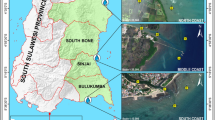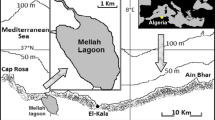Abstract
Distributional characteristics of dinoflagellate cysts in surface sediments were investigated in relation to environmental factors in the eastern part of Geoje Island, Korea. Samples were collected from 10 stations in February of 2004 and water temperature and salinity were measured in February, May, September and November of 2004. Total 30 taxa of dinoflagellate cysts were identified representing 19 genera, 28 species and 2 unidentified species. Among these dinoflagellate cysts,Brigantedinium spp. of which relative proportion in the total dinoflagellate cysts was 23.5%, was the most abundant at all stations except St. 1, and was followed bySpiniferites bulloideus (8.6%),Lingulodinium machaerophorum (8.2%) andDiplopsalis lenticula (6.7%). In addition, ellipsoidal cysts of the genusAlexandrium (Alexandrium catenella - tamarense type) andGymnodinium catenatum, known to be causative organisms for PSP, occurred with high concentrations.Scrippsiella trochoidea was also found; however, its cyst concentration was low. Generally, species composition in the study area was similar to these reported from Jinhae Bay and Busan Harbor and several dinoflagellate cysts reflected the eutrophic condition. Cyst distribution in the eastern part of Geoje Island seems to be influenced by the Tsushima Warm Current flowing from the southwest. The mean water temperature was 12.0°C in February, 14.7°C in May, 20.9°C in September and 17.2°C in November, which was most favorable forAlexandrium spp. growth. The abundances of dinoflagellate cysts ranged from 528 to 2,834 cysts/g dry sediment. Higher concentrations were recognized in sediments of west area of the Jisimdo than at other stations. The cyst composition of this area was closely related to these of Jinhae Bay and Busan Harbor from which currents flow into this area. Higher cyst concentration in the west area of Jisimdo might be due to formation of the gyre.
Similar content being viewed by others
References
An, K.H. 1998. Distribution of dinoflagellate cysts and growth characteristics of some harmful dinoflagellates in Korea. Ph.D. thesis, Pukyong National Univ., Korea. p. 20–22.
Chang, D.S., I.S. Shin, J.H. Pyeun, and Y.H. Park. 1987. A study on paralytic shellfish poison of sea mussel.Mytilus edulis, specimen caused food poisoning accident in Gamchun Bay, Pusan, Korea.Bull. Korean. Fish. Soc.,20(4), 293–299.
Chang, S.D., C.K. Kim, and J.S. Kim. 1993. Field observations and hydraulic model experiments of tidal currents in Chinhae Bay.Bull. Korean Fish. Soc.,26(4), 346–352.
Cho, H.J. and K. Matsuoka. 2001. Distribution of dinoflagellate cysts in surface sediments from the Yellow Sea and East Sea.Mar. Micropaleontol.,42, 103–123.
Choi, K.J., C.H. Ha, M.S. Han, J.K. Jeon, K.T. Kim, H.O. Lee, and M.Y. Yoon. 1999. Identification and characterization of Nitrate reductase in a marine dinoflagellateAlexandrium tamarense. Algae,14(3), 189–194.
Dale, B., T.A. Thorsen, and A. Fjellsa. 1999. Dinoflagellate cysts as indicator of cultural eutrophication in the Oslofjord, Norway.Estuar. Coast. Shelf Sci.,48, 371–382.
Goodman, D.K. 1987. Dinoflagellate cysts in ancient and modern sediments. p. 649–722. In:The Biology of Dinoflage l l a t e, ed. by F.J.R. Taylor. Blackwell, Oxford.
Han, M.S., J.K. Jeon, and Y.O. Kim. 1992.Alexandrium tamarense, a causative organism of paralytic shellfish poisoning in Chinhae Bay, Korea.J. Plankton Res.,14(12), 1581–1592.
Han, M.S., J.K. Jeon, and Y.H. Yoon. 1993. Distribution and toxin profiles ofAlexandrium tamarense (Lebour) Balech (Dinoflagellates) in the southeastern coastal waters, Korea. KoreanJ. Phycol.,8(1), 7–13.
Han, Y.H. and Y.S. Kim. 1985. Water quality and diffusion characteristics in the eastern sea of the Geoje Island.Bull. Korean Fish. Tech. Soc.,21(2), 99–104.
Harland, R., K. Nordberg, and H.L. Filipsson. 2004. The seasonal occurrence of dinoflagellate cysts in surface sediments from Koljö Fjord, west coast of Sweden-a note. Rev.Palaeobot. Palynol.,128, 107–117.
Head, M.J. 1996. Modern dinoflagellate cysts and their biological affinies. p. 1197–1248. In:Palynology: Principles and Applications, vol. 3, chapter 30. ed. by J. Jansonius and D.C. McGregor. American Association of Stratigraphic Palynologists Foundation, Dallas, Texas.
Hwang, J.D., Y.Q. Kang, Y.S. Suh, K.D. Cho, S.E. Park, L.H. Jang, and N.K. Lee. 2002. Estimation of the range of the suspended solid from the Nakdong River using satellite imageries and numerical model.Korean Assoc. Geogr. Inf. Stud.,5(2), 25–33.
Ichimi, K., M. Yamasaki, Y. Okumura, and T. Suzuki. 2001. The growth and cyst formation of a toxic dinoflagellate, Alexandrium tamarense, at low water temperatures in northeastern Japan.J. Exp. Mar. Biol. Ecol.,261, 17–29.
Jeon, J.K. and M.S. Han. 1998. Monitoring of intoxication and toxin composition on wild mussel (Mytilus corsucus) from coastal waters near Koje Island, Korea in 1996 and 1997.J. Korean Fish. Soc.,31(6), 817–822.
Joyce, L.B., G.C. Pitcher, A. du Randt, and P.M.S. Monteiro. 2005. Dinoflagellate cysts from surface sediments of Saldanha Bay, South Africa: An indication of the potential risk of harmful algal blooms.Harmful algae,4, 309–318.
Kim, M.S., K.S. Chu, and O.S. Kim. 1986. Investigation of some influence of the Nakdong River water on marine environment in the estuarine area using landsat imagery. Rep. Korea Min. Sci. Tech., p. 93–147.
Kim, H.G. 1990. Characteristics of flagellate red tide and environmental conditions in Masan Bay.Bull. Nat. Fish. Res. Dev. Agency,43, 1–40.
Kim, H.G., S.G. Lee, K.H. An, S.H. Youn, P.Y. Lee, C.K. Lee, E.S. Cho, J.B. Kim, H.G. Choi, and P.J. Kim. 1997. Recent red tides in Korean coastal waters. National Fisheries Research & Development Institute, Korea. p. 70–100.
Kim, H.G., P.Y. Lee, S.K. Lee, Y.C. Cho, and H.G. Choi. 2000. Handbook on Oceanography, Marine Environment and Harmful Algal Blooms. National Fisheries Research & Development Institute, Korea. 346 p.
Kim, H.J., C.H. Moon, and H.J. Cho. 2005. Spatial-temporal characteristics of dinoflagellate cyst distribution in sediments of Busan Harbor.J. Korean Soc. Oceanogr.,10(4), 196–203.
Kim, S.Y., C.H. Moon, and H.J. Cho. 2003. Relationship between dinoflagellate cyst in surface sediments and phytoplankton assemblages from Gwangyang Bay, a Southern coastal area of Korea.J. Korean Soc. Oceanogr.,8(2), 111–120.
Kim, Y.O., M.H. Park, and M.S. Han. 2002. Role of cyst germination in the bloom initiation ofAlexandrium tamarense (Dinophyceae) in Masan Bay, Korea.Aquat. Microb. Ecol.,29, 279–286.
Korea Hydrographic Office. 1986. Marine chart (No. 206). Jinhae Man and Approaches.
Lee, H.O., B.S. Cheun, E. Watanabe, and M.S. Han. 2000. Comparison of HPLC analysis and a channel biosensor in the detection of PSP toxin in naturalAlexandrium tamarense population.Algae,15(1), 61–64.
Lee, H.O., K.H. Choi, and M.S. Han. 2003. Spring bloom ofAlexandrium tamarense in Chinhae Bay, Korea.Aquat. Microb. Ecol.,33, 271–278.
Lee, J.B. and K.I. Yoo. 1991. Distribution of dinoflagellate cysts in Masan Bay, Korea.J. Oceanol. Soc. Korea,26(4), 304–312.
Lee, J.B. and K. Matsuoka. 1994. Distribution of dinoflagellate cysts from surface sediments in southern Korean waters. Proc. 2nd Int. Symp. Mar. Sci. Expl. Mar. Res., p. 1–20.
Lee, J.B., D.Y. Kim, and J.A. Lee. 1998. Community dynamic and distribution of dinoflagellates and their cysts in Masan-Chinhae Bay, Korea.J. Fish. Sci. Tech.,1(2), 283–292.
Lee, J.S., I.S. Shin, Y.M. Kim, and D.S. Jang. 1997. Paralytic shellfish toxin in the mussel,Mytilus edulis, caused the shellfish poisoning accident at Geoje, Korea, in 1996.J. Korean Fish. Soc.,30(1), 158–160.
Lee, J.S., J.K. Jeon, M.S. Han, Y. Oshima, and T. Yasumoto. 1992. Paralytic shellfish toxins in the musselMytilus edulis and dinoflagellateAlexandrium tamarense from Jinhae Bay, Korea.Bull. Korean Fish. Soc.,25(2), 144–150.
Marret, F., A. de Vernal, F. Bendera, and R. Harland. 2001. Late quaternary sea-surface conditions at DSDP Hole 594 in the southwest Pacific Ocean based on dinoflagellate cyst assemblages.J. Quat. Sci.,16, 739–751.
Marret, F. and K.A.F. Zonneveld. 2003. Atlas of modern organic-walled dinoflagellate cyst distribution.Rev. Palaeobot. Palynol.,125, 1–200.
Matsuoka, K. 1985. Organic walled dinoflagellate cysts from surface sediments of Nagasaki Bay and Senzaki Bay, W e s t J a p a n.Bull. Fac. Liberal Arts Nagasaki Univ. (Nat. Sci.),25, 21–115.
Matsuoka, K. 1999. Eutrophication process recorded in dinoflagellate cyst assemblage -a case of Yokahama Port, Tokyo Bay, Japan.Sci. Total Environ.,231, 221–233.
Matsuoka, K. and Y. Fukuyo. 2000. Technical guide for modern dinoflagellate cyst. WESTPAC-HAB/WESTPAC/IOC. 43 p. McMinn, A. 1992. Recent and late quaternary dinoflagellate cyst distribution on the continental shelf and slope of Southeastern Australia.Palynology,16, 13–24.
Park, G.H., K.Y. Kim, C.H. Kim and H.G. Kim. 2004. Spatiotemporal distribution of dinoflagellate resting cysts at the Saemangeum area.J. Kor. Fish. Soc.,37(3), 202–208.
Park, J.S. and H.G. Kim. 1991. Recent approaches on red tides. Korean and French seminar on red tide. 159 p.
Park, J.S. and Y.H. Yoon. 2003. Marine environmental characteri s t i c s by distribution of dinoflagellate cysts in the southern coastal waters of Korea. 1. Spatio-temporal distribution of dinoflagellate cysts in Gamak Bay.J. Korean Fish. Soc.,36(2), 151–156.
Park, J.S., Y.H. Yoon, I.H. Noh, and H.Y. Soh. 2005. A study of organic matter and dinoflagellate cyst on surface sediments in the central parts of south sea, Korea.Korean J. Environ. Biol.,23(2), 163–172.
Park, M.H., Y.K. Kim, S.Y. Cho, and M.S. Han. 2004. Effects of environmental conditions on germination ofAlexandrium tamarense cysts from Masan Bay, Korea.Korean J. Environ. Biol.,22(1), 200–205.
Sebastian, M.K.J and H. Willems. 2003. Calcareous dinoflag e l l a t e cysts in surface sediments from the Mediterranean Sea: distribution patterns and influence of main environmental gradients.Mar. Micropaleontol.,48, 321–354.
Shin, H.H. 2005. Distributional characteristics of dinoflagellate cysts on surface sediments in the southwest sea of Korea. MS thesis, Yosu National Univ., Korea. 70 p.
Suh, Y.S., L.H. Jang, and J.D. Hwang. 2001. Temporal and spatial variations of the cold waters occurring in the eastern coast of the Korean Peninsula in summer season.J. Korean Fish. Soc.,34(5), 435–444.
Author information
Authors and Affiliations
Corresponding author
Rights and permissions
About this article
Cite this article
Shin, H.H., Yoon, Y.H. & Matsuoka, K. Modern Dinoflagellate Cysts Distribution off the Eastern Part of Geoje Island, Korea. Ocean Sci. J. 42, 31–39 (2007). https://doi.org/10.1007/BF03020908
Received:
Revised:
Accepted:
Issue Date:
DOI: https://doi.org/10.1007/BF03020908




